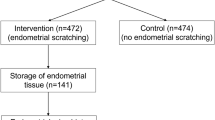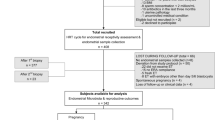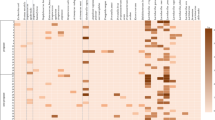Abstract
Purpose
A Lactobacillus-dominated microbiota in the endometrium was reported to be associated with favorable reproductive outcomes. We investigated in this study whether 16S ribosomal RNA (rRNA) gene sequencing analysis of the uterine microbiome improves pregnancy outcomes.
Methods
This prospective cohort study recruited a total of 195 women with recurrent implantation failure (RIF) between March 2019 and April 2021 in our fertility center. Analysis of the endometrial microbiota by 16S rRNA gene sequencing was suggested for all patients who had three or more failed embryo transfers (ETs). One hundred and thirty-one patients underwent microbial 16S rRNA gene sequencing (study group) before additional transfers, while 64 patients proceeded to ET without that analysis (control group). The primary outcome was to compare the cumulative clinical pregnancy rate of two additional ETs.
Main results
An endometrial microbiota considered abnormal was detected in 30 patients (22.9%). All but one of these 30 patients received antibiotics according to the bacterial genus detected in their sample, followed by treatment with probiotics. As a result, the cumulative clinical pregnancy rate (study group: 64.5% vs. control group: 33.3%, p = 0.005) and the ongoing pregnancy rate (study group: 48.9% vs. control group: 32.8%, p = 0.028) were significantly increased in the study group compared to the control group.
Conclusion
Personalized treatment recommendations based on the microbial 16S rRNA gene sequencing of the uterine microbiota can improve IVF outcomes of patients with RIF.
Trial registration
The University Hospital Medical Information Network (UMIN) Clinical Trial Registry: UMIN000036050 (date of registration: March 1, 2019).



Similar content being viewed by others
Data availability
The results of EMMA and datasets analyzed in this study are available from the corresponding author upon reasonable request. Here is the link to the data depository: https://center6.umin.ac.jp/cgi-bin/icdr_e/ctr_view.cgi?recptno=R000041006.
References
Turnbaugh PJ, Ley RE, Hamady M, Fraser-Liggett CM, Knight R, Gordon JI. The human microbiome project. Nature. 2007;449:804–10. https://pubmed.ncbi.nlm.nih.gov/17943116/
Peterson J, Garges S, Giovanni M, McInnes P, Wang L, Schloss JA, et al. The NIH Human Microbiome Project. Genome Res. 2009;19:2317–23. https://doi.org/10.1101/gr.096651.109.
Mitchell CM, Haick A, Nkwopara E, Garcia R, Rendi M, Agnew K, et al. Colonization of the upper genital tract by vaginal bacterial species in nonpregnant women. Am J Obstet Gynecol. 2015; 212:611.e1–611.e9. https://pubmed.ncbi.nlm.nih.gov/25524398/. Accessed 31 Aug 2022.
Moreno I, Codoñer FM, Vilella F, Valbuena D, Martinez-Blanch JF, Jimenez-Almazán J, et al. Evidence that the endometrial microbiota has an effect on implantation success or failure. Am J Obstet Gynecol. 2016; 215:684–703. http://www.ncbi.nlm.nih.gov/pubmed/27717732. Accessed 31 Aug 2022.
Chen C, Song X, Wei W, Zhong H, Dai J, Lan Z, et al. The microbiota continuum along the female reproductive tract and its relation to uterine-related diseases. Nat Commun. 2017;8. https://pubmed.ncbi.nlm.nih.gov/29042534/. Accessed 31 Aug 2022.
Romero R, Espinoza J, Mazor M. Can endometrial infection/inflammation explain implantation failure, spontaneous abortion, and preterm birth after in vitro fertilization? Fertil Steril. 2004; 82:799–804. https://pubmed.ncbi.nlm.nih.gov/15482749/. Accessed 31 Aug 2022.
Baker JM, Chase DM, Herbst-Kralovetz MM. Uterine microbiota: residents, tourists, or invaders? Front Immunol. 2018;9. https://pubmed.ncbi.nlm.nih.gov/29552006/. Accessed 31 Aug 2022.
Egbase PE, Al-Sharhan M, Al-Othman S, Al-Mutawa M, Udo EE, Grudzinskas JG. Incidence of microbial growth from the tip of the embryo transfer catheter after embryo transfer in relation to clinical pregnancy rate following in-vitro fertilization and embryo transfer. Hum Reprod. 1996; 11:1687–9. https://pubmed.ncbi.nlm.nih.gov/8921117/. Accessed 31 Aug 2022.
Egbase P, Udo E, Al-Sharhan M, Grudzinskas J. Prophylactic antibiotics and endocervical microbial inoculation of the endometrium at embryo transfer. Lancet. 1999;354:651–2. https://pubmed.ncbi.nlm.nih.gov/10466674/. Accessed 31 Aug 2022.
Salim R, Ben-Shlomo I, Colodner R, Keness Y, Shalev E. Bacterial colonization of the uterine cervix and success rate in assisted reproduction: results of a prospective survey. Hum Reprod. 2002;17:337–40. https://pubmed.ncbi.nlm.nih.gov/11821274/. Accessed 31 Aug 2022.
Fanchin R, Harmas A, Benaoudia F, Lundkvist U, Olivennes F, Frydman R. Microbial flora of the cervix assessed at the time of embryo transfer adversely affects in vitro fertilization outcome. Fertil Steril Fertil Steril. 1998;70:866–70. https://pubmed.ncbi.nlm.nih.gov/9806568/. Accessed 31 Aug 2022.
Selman H, Mariani M, Barnocchi N, Mencacci A, Bistoni F, Arena S, et al. Examination of bacterial contamination at the time of embryo transfer, and its impact on the IVF/pregnancy outcome. J Assist Reprod Genet. 2007; 24:395–9. https://pubmed.ncbi.nlm.nih.gov/17636439/. Accessed 31 Aug 2022.
Flyckt R, Davis A, Farrell R, Zimberg S, Tzakis A, Falcone T. Uterine transplantation: surgical innovation in the treatment of uterine factor infertility. J Obstet Gynaecol Can. 2018; 40:86–93. https://pubmed.ncbi.nlm.nih.gov/28821413/. Accessed 31 Aug 2022.
Simón C, Giudice LC. The endometrial factor: a reproductive precision medicine approach [Internet]. Endometrial Factor A Reprod. Precis. Med. Approach. 2017. https://www.routledge.com/The-Endometrial-Factor-A-Reproductive-Precision-Medicine-Approach/Simon-Giudice/p/book/9781498740395.
Moreno I, Cicinelli E, Garcia-Grau I, Gonzalez-Monfort M, Bau D, Vilella F, et al. The diagnosis of chronic endometritis in infertile asymptomatic women: a comparative study of histology, microbial cultures, hysteroscopy, and molecular microbiology. Am J Obstet Gynecol. 2018;218:602.e1–602.e16. https://pubmed.ncbi.nlm.nih.gov/29477653/. Accessed 31 Aug 2022.
Polisseni F, Bambirra EA, Camargos AF. Detection of chronic endometritis by diagnostic hysteroscopy in asymptomatic infertile patients. Gynecol Obstet Invest. 2003; 55:205–10. https://pubmed.ncbi.nlm.nih.gov/12904693/. Accessed 31 Aug 2022.
Cicinelli E, Resta L, Nicoletti R, Tartagni M, Marinaccio M, Bulletti C, et al. Detection of chronic endometritis at fluid hysteroscopy. J Minim Invasive Gynecol. 2005; 12:514–8. https://pubmed.ncbi.nlm.nih.gov/16337579/. Accessed 31 Aug 2022.
Nugent RP, Krohn MA, Hillier SL. Reliability of diagnosing bacterial vaginosis is improved by a standardized method of gram stain interpretation. J Clin Microbiol. 1991;29:297–301. https://pubmed.ncbi.nlm.nih.gov/1706728/. Accessed 31 Aug 2022.
Moreno I, Garcia-Grau I, Perez-Villaroya D, Gonzalez-Monfort M, Bahçeci M, Barrionuevo MJ, et al. Endometrial microbiota composition is associated with reproductive outcome in infertile patients. Microbiome. 2022;10:1–17. https://doi.org/10.1186/s40168-021-01184-w.
Cicinelli E, De Ziegler D, Nicoletti R, Colafiglio G, Saliani N, Resta L, et al. Chronic endometritis: correlation among hysteroscopic, histologic, and bacteriologic findings in a prospective trial with 2190 consecutive office hysteroscopies. Fertil Steril. 2008;89:677–84. https://pubmed.ncbi.nlm.nih.gov/17531993/
Honda H, Yokoyama T, Akimoto Y, Tanimoto H, Teramoto M, Teramoto H. The frequent shift to intermediate flora in preterm delivery cases after abnormal vaginal flora screening. Sci Rep. 2014; 4: 4799. www.nature.com/scientificreports
Farr A, Kiss H, Hagmann M, Machal S, Holzer I, Kueronya V, et al. Role of Lactobacillus species in the intermediate vaginal flora in early pregnancy: a retrospective cohort study. PLoS One; 2015;10. https://pubmed.ncbi.nlm.nih.gov/26658473/
Cicinelli E, Matteo M, Tinelli T, Lepera A, Alfonso R, Indraccolo U, et al. Prevalence of chronic endometritis in repeated unexplained implantation failure and the IVF success rate after antibiotic therapy. Hum Reprod. 2015;30:323–30. https://pubmed.ncbi.nlm.nih.gov/25385744/
Kitaya K, Matsubayashi H, Takaya Y, Nishiyama R, Yamaguchi K, Takeuchi T, et al. Live birth rate following oral antibiotic treatment for chronic endometritis in infertile women with repeated implantation failure. Am J Reprod Immunol. 2017;78. https://pubmed.ncbi.nlm.nih.gov/28608596/
McQueen DB, Perfetto CO, Hazard FK, Lathi RB. Pregnancy outcomes in women with chronic endometritis and recurrent pregnancy loss. Fertil Steril. 2015;104:927–31. https://pubmed.ncbi.nlm.nih.gov/26207958/
Johnston-MacAnanny EB, Hartnett J, Engmann LL, Nulsen JC, Sanders MM, Benadiva CA. Chronic endometritis is a frequent finding in women with recurrent implantation failure after in vitro fertilization. Fertil Steril. 2010;93:437–41. https://pubmed.ncbi.nlm.nih.gov/19217098/
Kitaya K, Matsubayashi H, Yamaguchi K, Nishiyama R, Takaya Y, Ishikawa T, et al. Chronic endometritis: potential cause of infertility and obstetric and neonatal complications. Am J Reprod Immunol. 2016;75:13–22. https://pubmed.ncbi.nlm.nih.gov/26478517/
Dominguez F, Gadea B, Mercader A, Esteban FJ, Pellicer A, Simón C. Embryologic outcome and secretome profile of implanted blastocysts obtained after coculture in human endometrial epithelial cells versus the sequential system. Fertil Steril. 2010;93. https://pubmed.ncbi.nlm.nih.gov/19062008/
Liu Y, Ko EYL, Wong KKW, Chen X, Cheung WC, Law TSM, et al. Endometrial microbiota in infertile women with and without chronic endometritis as diagnosed using a quantitative and reference range-based method. Fertil Steril. 2019;112:707–717.e1. https://pubmed.ncbi.nlm.nih.gov/31327470/
Buzzaccarini G, Vitagliano A, Andrisani A, Santarsiero CM, Cicinelli R, Nardelli C, et al. Chronic endometritis and altered embryo implantation: a unified pathophysiological theory from a literature systematic review. J Assist Reprod Genet. 2020;37:2897–911. https://pubmed.ncbi.nlm.nih.gov/33025403/
Benner M, Ferwerda G, Joosten I, Van Der Molen RG. How uterine microbiota might be responsible for a receptive, fertile endometrium. Hum Reprod Update. 2018;24:393–415. https://academic.oup.com/humupd/article/24/4/393/4971542
Antonio MAD, Meyn LA, Murray PJ, Busse B, Hillier SL. Vaginal colonization by probiotic Lactobacillus crispatus CTV-05 is decreased by sexual activity and endogenous Lactobacilli. J Infect Dis. 2009; 199:1506–13. https://pubmed.ncbi.nlm.nih.gov/19331578/
Ravel J, Gajer P, Abdo Z, Schneider GM, Koenig SSK, McCulle SL, et al. Vaginal microbiome of reproductive-age women. Proc Natl Acad Sci U S A. 2011; 108:4680–7. https://pubmed.ncbi.nlm.nih.gov/20534435/
Petrova MI, Lievens E, Malik S, Imholz N, Lebeer S. Lactobacillus species as biomarkers and agents that can promote various aspects of vaginal health. Front Physiol. 2015;6. https://pubmed.ncbi.nlm.nih.gov/25859220/
Wee BA, Thomas M, Sweeney EL, Frentiu FD, Samios M, Ravel J, et al. A retrospective pilot study to determine whether the reproductive tract microbiota differs between women with a history of infertility and fertile women. Aust N Z J Obstet Gynaecol. 2018; 58:341–8. https://pubmed.ncbi.nlm.nih.gov/29280134/
Acknowledgements
We thank Ms. Viviane Casaroli MSc, for her excellent help with English proofreading. We also wish to thank Ms. Yuko Takeda for data collection, and Ms. Nami Hirayama and Ms. Masae Shibasaki for the statistical analysis (both are clinical staff in the Kamiya Ladies Clinic). Finally, we would like to extend our gratitude to Professor Daiki Iwami Ph.D., from Jichi Medical University, for proofreading the manuscript.
Author information
Authors and Affiliations
Contributions
NI: protocol development, data analysis, data collection, and manuscript writing. MK, NO, TY, EW, MM, and OM: data collection. HK: data collection, protocol development, and supervision.
Corresponding author
Ethics declarations
Ethical approval
All procedures performed in this study were in accordance with the ethical standards of the Kamiya Ladies Clinic and with the 1964 Helsinki Declaration and its later amendments or similar ethical standards.
Informed consent
Informed consent was obtained from all individual participants included in the study.
Conflict of interest
The authors declare no competing interests.
Additional information
Publisher's note
Springer Nature remains neutral with regard to jurisdictional claims in published maps and institutional affiliations.
Rights and permissions
Springer Nature or its licensor (e.g. a society or other partner) holds exclusive rights to this article under a publishing agreement with the author(s) or other rightsholder(s); author self-archiving of the accepted manuscript version of this article is solely governed by the terms of such publishing agreement and applicable law.
About this article
Cite this article
Iwami, N., Kawamata, M., Ozawa, N. et al. Therapeutic intervention based on gene sequencing analysis of microbial 16S ribosomal RNA of the intrauterine microbiome improves pregnancy outcomes in IVF patients: a prospective cohort study. J Assist Reprod Genet 40, 125–135 (2023). https://doi.org/10.1007/s10815-022-02688-6
Received:
Accepted:
Published:
Issue Date:
DOI: https://doi.org/10.1007/s10815-022-02688-6




